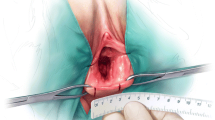Abstract
Introduction and hypothesis
Traditionally, it has been believed that posterior vaginal compartment prolapse was largely due to defects in the rectovaginal fascia, with surgical repairs concentrating on addressing this defect. We aimed to determine the relative size of defects at the different vaginal levels (I–III) following a large number of posterior vaginal compartment repairs (PRs) to determine whether this traditional viewpoint is still appropriate.
Methods
In a cross-sectional study of 300 consecutive PRs, mostly following prior or concomitant hysterectomy, two sets of markers of posterior compartment prolapse were used to measure anatomical defects at levels I–III: (i) from Pelvic Organ Prolapse Quantification (POP-Q) system points C, Ap, Bp, and genital hiatus (GH), and from Posterior Repair Quantification (PR-Q) perineal gap (PG), posterior vaginal-vault descent (PVVD), midvaginal laxity (MVL)—vault undisplaced, and rectovaginal fascial laxity (RVFL).
Results
The largest defects were found at level I (PVVD: mean 6.0 cm; point C, mean minus 0.9 cm), and level III (PG, mean 2.9 cm; GH, mean 3.7 cm). Level II defects (MVL—vault undisplaced, mean 1.3 cm; RVFL, mean 1.1 cm; points Ap, Bp, both mean 1.0 cm) were relatively small.
Conclusions
This study suggests that the defects found at surgery for posterior vaginal compartment prolapse were more frequent at the vaginal vault (level I) and vaginal introitus (level III) than at midvagina (level II). These findings should have implications for surgical planning.



Similar content being viewed by others
References
DeLancey JOL (1992) Anatomic aspects of vaginal eversion after hysterectomy. Am J Obstet Gynecol 166:1717–1728
Fowler GE, Richmond DH (2011) Operations for pelvic organ prolapse. In: Lopes T, Spirtos NM, Naik R, Monaghan JM Bonney’s Gynaecological Surgery, 11th edn. Wiley-Blackwell London. Chapter 16. P154
Nichols DH, Randall CL (1996) Posterior colporrhaphy and perineorrhaphy. In Nichols DH, Randall CL Vaginal surgery, 4th edn. Williams & Wilkins. Baltimore. Chapter 11 p279
Karram MM, Maher C (2013) Surgery for posterior vaginal wall prolapse. Int Urogynecol J 24(1835–1):841
Summers A, Winkel LA, Hussain HK, DeLancey JOL (2006) The relationship between anterior and apical compartment support. Am J Obstet Gynecol 194:1438–1443
Haylen BT, Avery D, Chiu TL, Birrell W (2014) Posterior repair quantification (PR-Q) using key anatomical indicators (KAI)–Preliminary Report. Int Urogynecol J 2014(25):1665–1672
Bump RC, Mattiasson A, Bo K, Brubaker LP et al (1996) The standardization of female pelvic organ prolapse and pelvic floor dysfunction. Am J Obstet Gynecol 175(1):10–11
Yang A, Mostwin J, Genadry R, Sanders R (1993) Patterns of prolapse demonstrated with dynamic fastscan MRI; reassessment of conventional concepts of pelvic floor weaknesses. Neurourol Urodyn 12(4):310–311
Haylen BT, Freeman RM, de Ridder D, Swift SE, Berghmans B, Lee J, Monga A, Petri E, Rizk D, Sand P, Schaer G (2010). An International Urogynecological Association (IUGA)–International Continence Society (ICS) Joint Report into the Terminology for Female Pelvic Floor Dysfunction. Neurourol Urodyn 29:4–20. Int Urogynecol J 21:5–26
Haylen BT, Vu D, Birrell W, Vashevnik S, Tse K (2012) A preliminary anatomical basis for dual (uterosacral and sacrospinous ligaments) vaginal vault support at colporrhaphy. Int Urogynecol J 23:879–882
Samaan A, Vu D, Haylen BT, Tse K (2014) Cardinal ligament surgical anatomy: cardinal points at hysterectomy. Int Urogynecol J 25(2):189–195
Vu D, Haylen BT, Tse K, Farnsworth A (2010) Surgical anatomy of the uterosacral ligament. Int Urogynecol J 21:1123–1128
McCall ML (1957) Posterior culdoplasty: surgical correction of enterocoele during vaginal hysterectomy; a preliminary report. Obstet Gynecol 10:595–602
Montella JM, Morrill MY (2005) Effectiveness of the McCall culdeplasty in maintaining support after vaginal hysterectomy. Int Urogynecol J 16:226–229
Francis WFA, Jeffcoate TNA (1961) Dyspareunia following vaginal operations. J Obstet Gynaecol Br Commonw 68:1–10
Richardson AC (1993) The rectovaginal septum revisited: its relationship to rectocele and its importance in rectocele repair. Clin Obstet Gynecol 36:976–983
Richardson AC (1995) The anatomic defects in rectocele and enterocele. J Pelvic Surg 1:214–221
Lewicky-Gaupp C, Yousuf A, Larson KA, Fenner DE, DeLancey JOL (2010) Structural position of the posterior vagina and pelvic floor in women with and without posterior vaginal prolapse. Am J Obstet Gynecol 202(5):497
Ghetti C, Grerory WT, Edwards SR, Otto LN, Clark AL (2005) Severity of pelvic organ prolapse associated with measurements of pelvic floor function. Int Urogynecol J 16:432–436
Haylen BT, Birrell W, Naidoo S, Younis M (2014) Perineorrhaphy quantitative assessment (Pe-QA). Int Urogynecol J 26(4):539–544
Acknowledgments
The authors thank the theater teams at St. Vincent’s and Mater Hospitals, Sydney, for providing support and facilitating this study. We acknowledge surgical assistant Dr. John McNamara as an additional observer to measurements, anesthetists for their support and patience, associate professor Alan Molloy and Drs. Colleen Kane, Simon Adamo, Luke Vyvyan, and Alex Wang, who recorded most measurements.
Author information
Authors and Affiliations
Corresponding author
Ethics declarations
Conflicts of interest
None.
Electronic supplementary material
Below is the link to the electronic supplementary material.
ESM 1
(DOCX 37 kb)
Rights and permissions
About this article
Cite this article
Haylen, B.T., Naidoo, S., Kerr, S.J. et al. Posterior vaginal compartment repairs: Where are the main anatomical defects?. Int Urogynecol J 27, 741–745 (2016). https://doi.org/10.1007/s00192-015-2874-7
Received:
Accepted:
Published:
Issue Date:
DOI: https://doi.org/10.1007/s00192-015-2874-7




